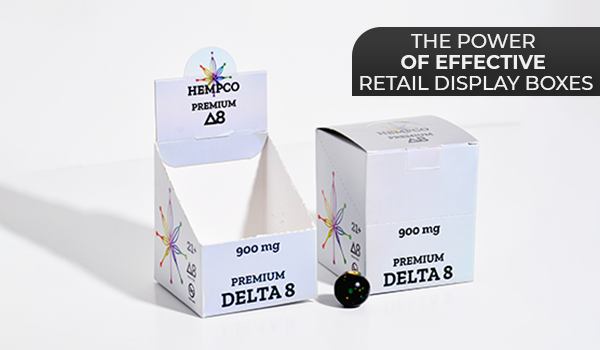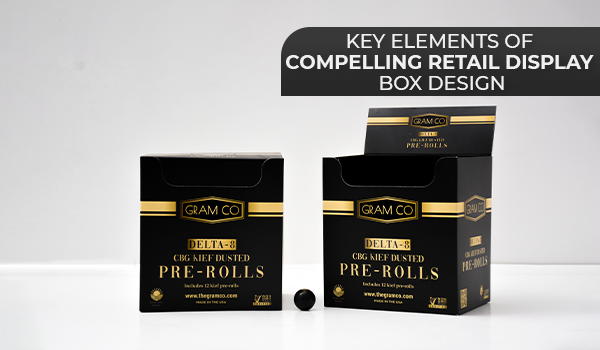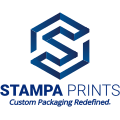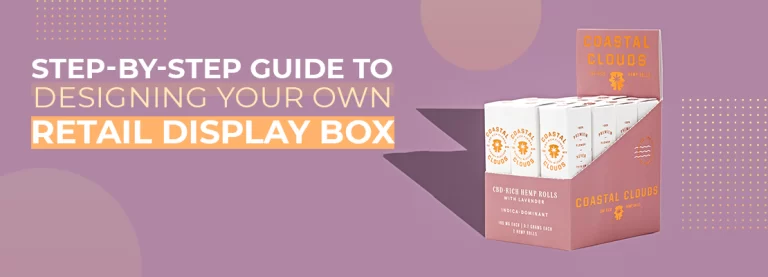The act of designing a retail display box must not be overlooked as far as product presentation and marketing are concerned. Protecting the product sufficiently and enhancing its appearance to attract customers makes a display box that works well.
Design your own retail display box by following this guide as it tackles understanding your audience and incorporating marketing strategies and sustainability practices.
The Power of Effective Retail Display Boxes

Retail display boxes are influential marketing tools as they provide multiple functionalities. These include ensuring the safety of products, conveying product details, and boosting product aesthetics. A good display box can add a lot of value to how one decides whether to purchase a product.
Understanding Your Audience and Product
Identify your audience and what your product represents before entering the design process. Take the following into consideration:
- Target Audience: Identify the demographics and preferences of your potential customers.
- Product Features: Emphasize the special characteristics of your product
- Brand Identity: Ensure that your design is consistent with your brand’s looks and core values.
Key Elements of Compelling Retail Display Box Design

Several elements contribute to an effective display box design:
- Visual Appeal: Make sure colors, fonts, and images that are beautiful, and can take your attention.
- Durability: Ensure the box is sturdy enough to protect the product.
- Functionality: Design the box in a way that is easy to handle and display it.
- Information: Clearly present important details such as the product’s name, attributes, and logo.
Step-by-Step Guide to Designing Your Retail Display Box
-
Determine Box Dimensions:
Take your product measurements to find the right box size. Then, consider the typical carton sizes to optimize production and shipping costs.
-
Select Cardboard Thickness and Density:
Given the product’s weight and fragility, select the right depth and density. The density of cardboard typically ranges from 0.4 to 0.7 grams per cubic centimeter.
-
Design the Box Structure:
Draw your box’s fundamental layout, including the flaps, cuts, and folds. Use software like Adobe Illustrator or specific packaging design software to make it.
-
Create Visual Design:
Develop your box’s visual elements such as brand colors, logo and product images. Ensure the design remains consistent with your brand’s identity and is attractive to your target population.
-
Add Essential Information:
Include necessary details such as product description, instructions, and barcodes. Make sure the information is easy to read and well-organized.
-
Prototype and Test:
Produce a model that represents your style and then try to ascertain whether it is tough, discrete, and attractive. Based on feedback and testing results, make adjustments.
Incorporating Marketing Strategies into Your Design
Your display box should serve as a marketing tool
- Branding: Consistent branding elements should be used to reinforce brand recognition.
- Promotions: Highlight any special offers or promotions on the box.
- Call to Action: Convincing the customers into taking action, for example, to visit your website or follow you on social media.
Sustainability and Eco-Friendly Packaging Solutions
Sustainability is increasingly important in packaging design. Consider using:
- Recyclable Materials: Consider choosing paperboard and other recycled materials.
- Eco-Friendly Inks: Use less dangerous ink in relation to the environment.
- Minimalist Design: Ensure materials are used in minimal quantities to reduce wastage.
The Role of Technology in Modern Retail Display Box Design
Technology plays a significant role in modern packaging design:
- 3D Modeling Software: It enables accurate drafting and display of the box. So you can easily modify your box to your liking before starting printing
- Digital Printing: Enables high-quality printing options available at low costs. Perfect for starting or small businesses
- Augmented Reality: By providing interactive elements, to increase boosts in customer interaction.
Common Mistakes to Avoid in Retail Display Box Design
Avoid these common pitfalls:
- Overcomplicating the Design: Keep it simple and functional. Go for clean lines, minimalistic graphics, and prominent branding to convey the product’s message effectively
- Ignoring the Target Audience: Ensure your plan is liked by your target audience. Research and understand the preferences and demographics of your target audience to create a design that resonates with them
- Neglecting Durability: Ensure the box can withstand shipping and handling. Prioritize sturdy materials and reinforced construction to ensure the box maintains its integrity.
Conclusion
Creating a good-looking retail display box for your products can be a complex thing, needing aesthetics, functionality, and corporate branding-effective strategies to succeed. The process starts with getting your audience well-identified; this ensures that whatever design you choose will address such consumers.
By following this guide, you can design a retail display box that meets your practical needs, effectively markets your product, and aligns with modern sustainability practices.
The knowledge of your customers, together with things they like, can have a huge effect on how you can attract their attention and force them into buying your product. Whether you’re looking for inspiration or ready to start designing, Stampa Prints offers the tools and expertise to bring your vision to life.
FAQ’s
Q1. What role does packaging play in retail success?
Packaging plays an important role in the protection of the product, provision of information, and improvement of the visual appearance to attract the customers that determine the choice while buying
Q2. How can I ensure my retail display box stands out on the shelf?
Create a visually appealing and noticeable box by including attractive colors, clear branding, and unique selling points.
Q3. Why is sustainability important in packaging design?
Sustainability involves several things, such as decreasing environmental impact, satisfying the needs of consumers who demand environmentally friendly products, and improving the reputation of the brand.
Q4. What software tools are recommended for designing retail display boxes?
Adobe Illustrator, Artwork Flow, and Canva are popular tools for designing and prototyping retail display boxes.
Q5. How do I know if my retail display box design is effective?
Gather feedback from potential customers to test the durability, functionality, and visual appeal of the prototypes made. Make any necessary changes based on the feedback received.



